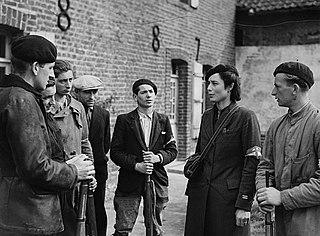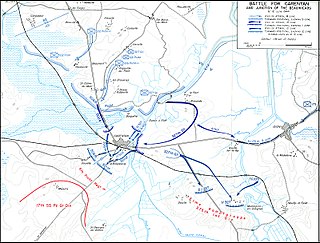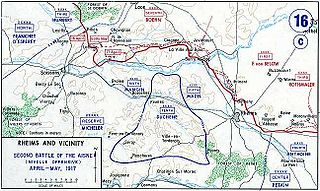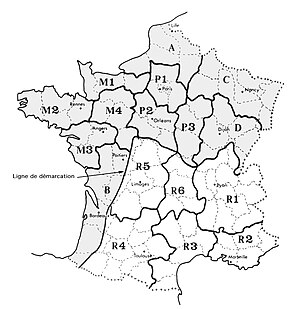|
|---|
| Africa and Middle East |
|---|
| | Europe |
|---|
| | Indian Ocean and Asia |
|---|
|
|
The Maquis du Mont Mouchet were a group of French resistance fighters during the Second World War that were based at Mont Mouchet.
The Germans, having discovered the maquis, made several attacks up until May 1944 with about 3,000 men and using aviation and armoured units. The maquisards fought back fiercely.
Little information is available on the German forces. Historians have identified some units:
- The Jesser Brigade, formed from veterans of the eastern front (deployed in the Orléans-Pithiviers sector)
- Sicherungs-Regiment 1000
- Aufklärungsabteilung 1000
These were reinforced from:
After several days of combat, the final German attack forced the maquisards to fall back and disperse. Out of revenge for their previous losses, the Germans pillaged several of the surrounding villages, including Clavières.
In the course of the battles, the French Forces of the Interior sustained severe losses: 238 killed and 180 wounded as well as about 100 hostages executed by the Nazis.

The French Foreign Legion is a military service branch of the French Army established in 1831. Legionnaires are highly trained infantry soldiers and the Legion is unique in that it is open to foreign recruits willing to serve in the French Armed Forces. When it was founded, the French Foreign Legion was not unique; other foreign formations existed at the time in France. The Foreign Legion is today known as a unit whose training focuses on traditional military skills and on its strong esprit de corps, as its men come from different countries with different cultures. Consequently, training is often described as not only physically challenging, but also very stressful psychologically. French citizenship may be applied for after three years' service. The Legion is the only part of the French military that does not swear allegiance to France, but to the Foreign Legion itself. Any soldier who gets wounded during a battle for France can immediately apply to be a French citizen under a provision known as "Français par le sang versé". As of 2018, members came from 140 countries.

The Maquis were rural guerrilla bands of French Resistance fighters, called maquisards, during the Nazi occupation of France in World War II. Initially, they were composed of young, mostly working class, men who had escaped into the mountains and woods to avoid conscription into Vichy France's Service du travail obligatoire to provide forced labor for Germany. To avert capture and deportation to Germany, they became increasingly organized into active resistance groups.

The French Resistance was the collection of French movements that fought against the Nazi German occupation of France and the collaborationist Vichy régime during the Second World War. Resistance cells were small groups of armed men and women, who, in addition to their guerrilla warfare activities, were also publishers of underground newspapers, providers of first-hand intelligence information, and maintainers of escape networks that helped Allied soldiers and airmen trapped behind enemy lines. The men and women of the Resistance came from all economic levels and political leanings of French society, including émigrés, academics, students, aristocrats, conservative Roman Catholics, Huguenots, Jews, Muslims, liberals, anarchists, nationalists and communists.

The Combat of the Côa was a skirmish that occurred during the Peninsular War period of the Napoleonic Wars. It took place in the valley of the Côa River and it was the first significant battle for the new army of 65,000 men controlled by Marshal André Masséna, as the French prepared for their third invasion of Portugal.

The Battle of Carentan was an engagement in World War II between airborne forces of the United States Army and the German Wehrmacht during the Battle of Normandy. The battle took place between 6 and 13 June 1944, on the approaches to and within the town of Carentan, France.

The Maquis des Glières was a Free French Resistance group, which fought against the 1940–1944 German occupation of France in World War II. The name is also given to the military conflict that opposed Resistance fighters to German, Vichy and Milice forces.

The French Foreign Legion has had a long and unique history amongst the units of the French Army. It was historically formed of expatriate enlisted personnel led by French officers. Founded by a royal ordinance issued by King Louis Philippe of France on March 9, 1831 with aim of bolstering the strength of the French Army while also finding a use for the influx of refugees inundating France at the time. The Foreign Legion subsequently found a permanent home in the ranks of the French military. The Foreign Legion's history spans across Conquest of Algeria, the Franco-Prussian War, numerous colonial exploits, both World Wars, the First Indochina War, and the Algerian War.

The Maquis du Vercors was a rural group of the French Forces of the Interior (FFI) (maquis) that resisted the 1940–1944 German occupation of France in World War II. The Maquis du Vercors used the prominent scenic plateau known as the Massif du Vercors as a refuge. Initially the maquis carried out only sabotage and partisan operations against the Germans, but after the Normandy Invasion on 6 June 1944, the leadership of an army of about 4,000 maquis declared the "Free Republic of Vercors," raised the French flag, and attempted to create a conventional army to oppose the German occupation.
Polish 3rd Legions Infantry Division was a tactical unit of the Polish Army between the World Wars. Formed in 1919, as a third unit composed significantly of veterans of the Polish Legions in World War I, it saw extensive action during the Polish-Bolshevik War and the Invasion of Poland. In the interbellum period, the headquarters of the division was stationed in Zamość, while its regiments were garrisoned in Chelm, Lublin, Zamosc and other locations.

The 4th Infantry Division Livorno was a mountain infantry division of the Italian Army during World War II. The division was formed on 5 April 1939 in Rome. The only difference between line infantry divisions and mountain infantry divisions was that the latter's artillery was carried by pack mules instead of the standard horse-drawn carriages. Italy's real mountain warfare divisions were the six alpine divisions manned by the "Alpini" mountain troops.

Mont Mouchet is a 1,497-metre-high (4,911 ft) mountain located on the border of the French départements of Cantal, Haute-Loire and Lozère. It is famous for the historical events which took place there, notably during the Second World War where it hosted a group of French resistance fighters, the Maquis du Mont Mouchet. At the summit there is a large cairn and view-point from which there is a splendid panoramic view over much of Central France from the Massif Central to the Alps.

The 11th Infantry Division Brennero was a mountain infantry division of the Italian Army during World War II. The Brennero Division was mobilized in October 1939, demobilized in October, 1940, and mobilized again in December, 1940. The only difference between line infantry divisions and mountain infantry divisions was that the latter's artillery was carried by pack mules instead of the standard horse-drawn carriages. Italy's real mountain warfare divisions were the six alpine divisions manned by the "Alpini" mountain troops. It began transformation to motorized division in February, 1943.

The Battle of the Hills also known as the Battle of the Hills of Champagne and the Third Battle of Champagne, was a battle of the First World War that was fought from April–May 1917. The French Fourth Army offensive against the German 4th Army was to support the Groupe d'armées du Nord along the Chemin des Dames, in the Second Battle of the Aisne. General Anthoine, commander of the Fourth Army planned a supporting attack but this was rejected by Nivelle and Anthoine planned a frontal attack by two corps on an 11 km (6.8 mi) front, to break through the German defences on the first day and commence exploitation the following day. The battle took place east of Reims, between Prunay and Aubérive, in the province of Champagne, along the Moronvilliers Hills.

Lt. Col Frederick Henry Cardozo MC was a British soldier and SOE veteran. Cardozo was brought up in the Loire Valley between 1923 and 1933.

Émile Coulaudon, known as Colonel Gaspard, was one of the principal leaders of the French Resistance in Auvergne during the Second World War.
Adrien Pommier was a member of the French Resistance during World War II.

The Marching Regimentof the French Foreign Legion (RMLE) was a French military unit that fought in World War I and World War II. Initially composed of marching regiments from the 1st Foreign Regiment of Sidi Bel Abbes and the 2nd Foreign Infantry Regiment of Saida, Algeria, it re-formed as the 3rd Foreign Infantry Regiment.
The 2nd Marching Regiment of the 1st Foreign Regiment, was a French Military unit of the Legion which formed the Marching Regiment of the Foreign Legion (R.M.L.E) and existed ephemerally from end of 1914 to 1915.
The Freiwilligen-Stamm-Division was a German infantry division of the Wehrmacht during World War II. It was created on 1 February 1944 in Southern France. The Division was a so-called Ostlegion, which means its personnel was made up from volunteers from the Soviet Union. Specifically Freiwilligen-Stamm-Division consisted of Turkic, Azerbaijani, Georgian, Tartar, Cossack, Armenian and other Soviet volunteers, spread over five regiments. The primary purpose of the division were anti-partisan operations against the French Resistance.

During the Second World War, the Oisans maquis was an important center for the French Resistance, in the Oisans region between the Belledonne range and Grenoble to the north, the Grandes Rousses massif of the Alps and the Croix de Fer pass to the east, the Drac valley to the west and the Barre des Écrins and the Provencal Alps to the south.


















